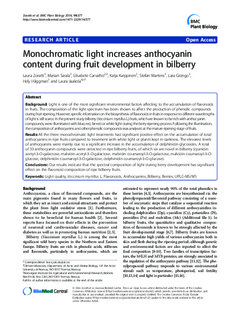| dc.contributor.author | Zoratti, Laura | |
| dc.contributor.author | Sarala, Marian | |
| dc.contributor.author | Carvalho, Elisabete | |
| dc.contributor.author | Karppinen, Katja | |
| dc.contributor.author | Martens, Stefan | |
| dc.contributor.author | Giongo, Lara | |
| dc.contributor.author | Häggman, Hely | |
| dc.contributor.author | Jaakola, Laura | |
| dc.date.accessioned | 2015-02-23T13:50:20Z | |
| dc.date.accessioned | 2017-08-25T07:47:19Z | |
| dc.date.available | 2015-02-23T13:50:20Z | |
| dc.date.available | 2017-08-25T07:47:19Z | |
| dc.date.issued | 2014 | |
| dc.identifier.citation | Zoratti, L., Sarala, M., Carvalho, E., Karppinen, K., Martens, S., Giongo, L., ... & Jaakola, L. (2014). Monochromatic light increases anthocyanin content during fruit development in bilberry. BMC plant biology, 14(1), 377. | nb_NO |
| dc.identifier.issn | 1471-2229 | |
| dc.identifier.uri | http://hdl.handle.net/11250/2451817 | |
| dc.description.abstract | Background: Light is one of the most significant environmental factors affecting to the accumulation of flavonoids in fruits. The composition of the light spectrum has been shown to affect the production of phenolic compounds during fruit ripening. However, specific information on the biosynthesis of flavonoids in fruits in response to different wavelengths of light is still scarce. In the present study bilberry (Vaccinium myrtillus L.) fruits, which are known to be rich with anthocyanin compounds, were illuminated with blue, red, far-red or white light during the berry ripening process. Following the illumination, the composition of anthocyanins and other phenolic compounds was analysed at the mature ripening stage of fruits.
Results: All the three monochromatic light treatments had significant positive effect on the accumulation of total anthocyanins in ripe fruits compared to treatment with white light or plants kept in darkness. The elevated levels of anthocyanins were mainly due to a significant increase in the accumulation of delphinidin glycosides. A total of 33 anthocyanin compounds were detected in ripe bilberry fruits, of which six are novel in bilberry (cyanidin acetyl-3-O-galactose, malvidin acetyl-3-O-galactose, malvidin coumaroyl-3-O-galactose, malvidin coumaroyl-3-Oglucose, delphinidin coumaroyl-3-O-galactose, delphinidin coumaroyl-3-O-glucose).
Conclusions: Our results indicate that the spectral composition of light during berry development has significant effect on the flavonoid composition of ripe bilberry fruits. | nb_NO |
| dc.language.iso | eng | nb_NO |
| dc.publisher | BioMed Central | nb_NO |
| dc.rights | Navngivelse 4.0 Internasjonal | * |
| dc.rights.uri | http://creativecommons.org/licenses/by/4.0/deed.no | * |
| dc.title | Monochromatic light increases anthocyanin content during fruit development in bilberry | nb_NO |
| dc.type | Journal article | nb_NO |
| dc.type | Peer reviewed | nb_NO |
| dc.date.updated | 2015-02-23T13:50:20Z | |
| dc.description.version | publishedVersion | nb_NO |
| dc.rights.holder | © 2014 Zoratti et al.; licensee BioMed Central. This is an Open Access article distributed under the terms of the Creative Commons Attribution License (http://creativecommons.org/licenses/by/4.0), which permits unrestricted use, distribution, and reproduction in any medium, provided the original work is properly credited. The Creative Commons Public Domain Dedication waiver (http://creativecommons.org/publicdomain/zero/1.0/) applies to the data made available in this article, unless otherwise stated. | nb_NO |
| dc.source.pagenumber | 10 | nb_NO |
| dc.source.volume | 14 | nb_NO |
| dc.source.journal | BMC Plant Biology | nb_NO |
| dc.identifier.doi | 10.1186/s12870-014-0377-1 | |
| dc.identifier.cristin | 1189726 | |

